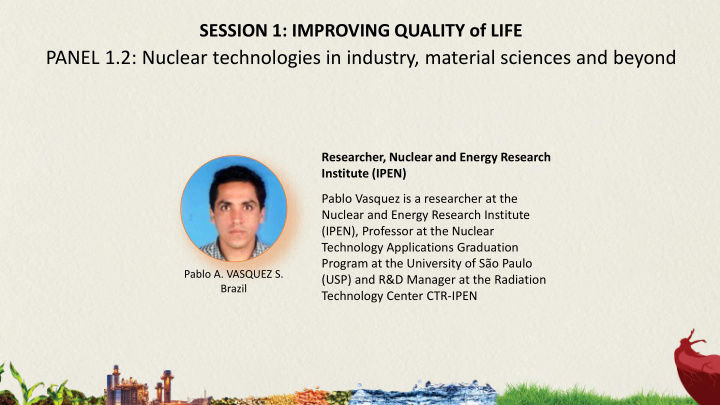



SESSION 1: IMPROVING QUALITY of LIFE PANEL 1.2: Nuclear technologies in industry, material sciences and beyond Researcher, Nuclear and Energy Research Institute (IPEN) Pablo Vasquez is a researcher at the Nuclear and Energy Research Institute (IPEN), Professor at the Nuclear Technology Applications Graduation Program at the University of São Paulo Pablo A. VASQUEZ S. (USP) and R&D Manager at the Radiation Brazil Technology Center CTR-IPEN
Radiation Technology: From High Performance Materials, To Preserving Cultural Heritage Pablo Vasquez Nuclear and Energy Research Institute – IPEN São Paulo - Brazil
Radiation Technologies are present in daily life People around the world are benefiting from the use of radiation technologies Radiation Processing - Practical application of radiation chemistry; - Use of the energy of ionizing radiation - high energy - (gamma, electrons and X-ray) by introducing biological, physical and chemical effects in the irradiated product. https://www.youtube.com/watch?v=ePiNdzWjoWM
Challenges and advantages of Radiation Processing Radia iation Cr Crosslin inkin ing for • Production of new producti tion of of poly olymer products materials with special characteristics; • Less chemicals (e.g. organic solvents) are needed; • Less energy consumption; • Less environment Rubber vulcanization Foamed polymers pollution ; • Economically favourable Wire and cable insulations technologies; Heat shrincable products: • Standardized process control methods;
Food Irradiation - to decrease food losses during storage (20-30 % of food production is lost due to pests, insects, bacteria, fungi); - to decrease microbial contamintion (pathogens, parasites result in food-borne deseases); - to avoid infection it looks to be the best solution; Human Tissues and prothesis Sterilization Radiation Sterilization -Based on microbiological effect: - Single use medical devices (60 % of production) - food packaging materials; - food for astronauts and for hospitals;
Surface Coating • Simultaneous radiation polymerization and crosslinking of monomer and oligomer molecules on the surface of e.g. wood, metal, paper, ceramics, film resulting in a homogeneous layer in room temperature without using solvents Radiation Grafting • Industries: printing, furniture, building, etc. Monomer or oligomer function group is connected to a polymer molecule by ionizing radiation resulting in new • New: low energy curing of pigmented product of new characteristics. coatings on metal coil (energy saving). Application fields: - packaging materials (PE coated Al foil) - textile products (better colourization) - health care products (increased biocompatibility) - battery separators - FUEL CELL MEMBRANES GRAFTED USING IONIZING RADIATION
Release Technologies • Biomedical products – production of hydrogels: (hydrophylic polymers: PVP, PVA) -Wound dress and prevention of bedsore. • Radiation treatment of postal packages (anthrax). • Composite materials – e.g. SiC ( o C) for space research; carbon fibers for e.g. car industry; • Nanogels for controlled release drug-delivery systems; Hydrogel • Surface decontamination of packaging (asseptic) materials • Radiation degradation: natural (cellulose, polysaccharides) and artificial (teflon) polymers to smaller molecular weight parts of smaller viscosity: - viscose industry (less chemicals and energy requirement); paper industry; ink production (from teflon waste); cellulose containing waste to produce, animal food; agriculture (chitin e.g.)
Environmental Protection Technologies Waste water and drinking water treatment: Remove impurities of biological (pathogens) and/or of industrial origin (organic compounds); Advantages: - on-line technology; - no chemical contamination; - combined treatment is possible (chlorination, ozone, filtration); Industries: - Paper production and textile industry; - Communale waste water;
Environmental Protection Technologies Sludge treatment: Utilization of irradiated sludge (5 – 10 kGy) as fertilizer in agriculture, if its heavy metal content is negligible. On-line procedure. Flue gas treatment: Coal and oil based power stations emit sulphur and nitrogen containing gases, resulting in „ acidic rain ” . Responsible also for the formation of smog and green house effect. SO 2 (~ 95 %) and NO x (~ 80 %) removal. NH 3 addition to produce fertilizers. Use of low energy accelerators.
Cultural Heritage artefacts and archived materials disinfection and consolidation https://www.iaea.org/newscenter/news/culture-meets-nuclear-science-in-brazil
Thanks!
Recommend
More recommend